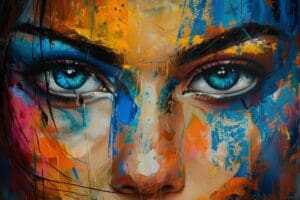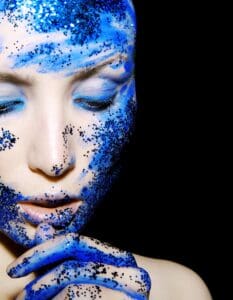New Category Of Art
The word, “fluidism”, can be used to label a distinctive category of fine art painting where both the substrate and the subject are the same. “Substrate” means the actual material from which a painting is constructed (i.e., the paint). “Subject” means the intellectual motivation from which a painting grows(i.e., the meaning, representation, or purpose).
In fluidism art, the substrate (i.e., what the painting is made of) and the subject (i.e., what the painting is about) are inseparable. The substrate IS the subject, and the subject IS the substrate. The visual and verbal appeal of fluids extends directly from physical properties, chemical characteristics, and dynamical patterns of fluids in motion. In fluidism art, both the perceptual and the conceptual appeal of fluids interact to produce deep enlightenment.
Fluidism paintng, thus, is the activity of mixing and manipulating real fluids, in order to discover, to experience, and to present fluid dynamic patterns as ephemeral forms of art.
Primal Source Of Inspiration and Intelligence
Throughout history, various artists have engaged in creative activities that fit the label, “fluidism”. More than 2000 years ago, Shinto priests of ancient China, for example, created sacred art by dropping ink into ponds and transferring the resulting concentric patterns to rice paper. Ancient Japanese artists, during the twelfth century, refined this ink-dropping style into what later came to be classified formally as suminagashi, which means “floating ink “. Craftspeople in the Ottoman Empire, during the fifteenth century, developed a closely related painting style called “ebru”, which roughly means “cloud art.”
In modern times, a technique known as “marbling” came into fashion in the West, subsequently falling out and into fashion periodically. Closer to the present-day, as the physics of fluid dynamics progressed, various science students discovered the beauty of this physics, which resulted in some scientific-minded people turning their primary interests towards the art of fluid dynamics. One such scientist-turned-artist, for example, is Chris Parks, who originally studied engineering at the Imperial College, London.
Most of the world’s religions appear to have always had a close connection to fluids that ran parallel to artistic and scientific interests. The idea that life and reality arose from fluids, in fact, seems widespread in the world’s various beliefs, from Ancient Egyptian myths to modern Judeo-Christian stories of creation.
While select artists throughout history have found great inspiration in fluids, and while modern science has made extensive use of fluid dynamical ideas, almost all religions have revered fluid as the origin and foundation of reality, as we know it.
Modern astronauts have played with fluid water in the weightlessness of outer space. Contemporary painters have played with fluid paints in the minimal-gravity conditions of parabolic airplane flights. Don Petit is one such astronaut, and Frank Pietronigro is one such painter. Both metaphysics and physics now revere fluid in each field’s own special way.
Consequently, a special word, “fluidism”, seems justified to help unify this widespread, human creative interest.
Transcendental Action Painting
American painter, Jackson Pollock (1912-1956) might best be regarded as the premier fluidism artist. Art critics of his day referred to him as an “abstract expressionist” or, more specifically, as a “drip painter” or “action painter.” Pollock, however, probably understood fully that he was not intentionally expressing anything. Rather, he was the expression itself–both the substance and the action of the expression, without any formal intentions to be either. Pollock realized that spontaneous actions could result in pleasing patterns. His dried painted patterns were frozen echoes of his once liquid actions. Pollock, thus, was an extension of the active flow of his chosen substrate (i.e., paint). He could register residual patterns of his actions in the original paint medium, because these patterns were stable while still wet. Pollock’s fluid patterns dried in almost the exact same appearances as their wet counterparts.
The advent and advancement of photography has shown clearly that some fluid patterns cannot dry in their original substrates. These fluid patterns either are too transient, or they are destroyed by drying. In other words, some visually appealing moments of wet flow cannot be preserved in the original substrates where they emerge. A bubble, for example, pops. A splashing sheet of liquid quickly moves from the air back into the mass from which it splashed. A particular collision or striation of liquid layers dissipates, before the mechanics of drying can even take hold to contain those patterns. Clearly, the idea of “painting” extends beyond the substrate of the dry painted artifact.
Photography has shown that painting is, or can be, an action where certain patterns cannot be captured, unless an artist transcends the medium in which those patterns originate. A photographic artist, thus, can capture an impression of a bubble before the bubble pops. A photographic artist can virtually freeze a flying sheet of liquid before the sheet crashes back into its mother pool. A photographic artist can immobilize a particularly appealing color collision or a particular striation of colored liquid bands, before they dissipate into homogeneous solution. Patterns once invisible because of the speed of particular actions now can be made visible by the stop-action capability of the photographic artist’s camera. Photography makes possible a class of action paintings that defy the traditional static definition of the word, “painting”.
Fluidism, then, has evolved from various traditions that involve manipulating wet liquids and allowing these liquids to dry. Fluidism has evolved into the modern pursuit of photographing manipulated liquids while they are still wet. Traditionally, only dried remnants of stable wet patterns were possible artifacts. Now virtual dried remnants (i.e., photographs) of ephemeral, impossible-to-dry patterns are possible. These are “transcendental action paintings”–profound extensions of the basic idea of “painting.”
Copyright (c) 2011 Robert G. Kernodle




